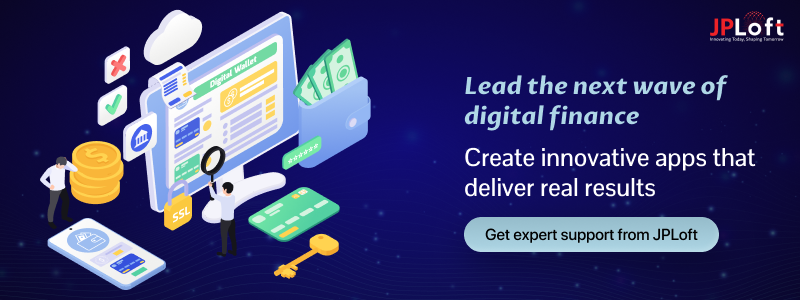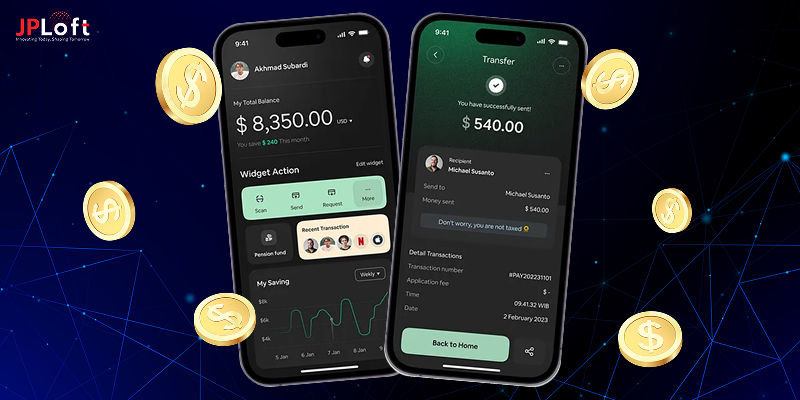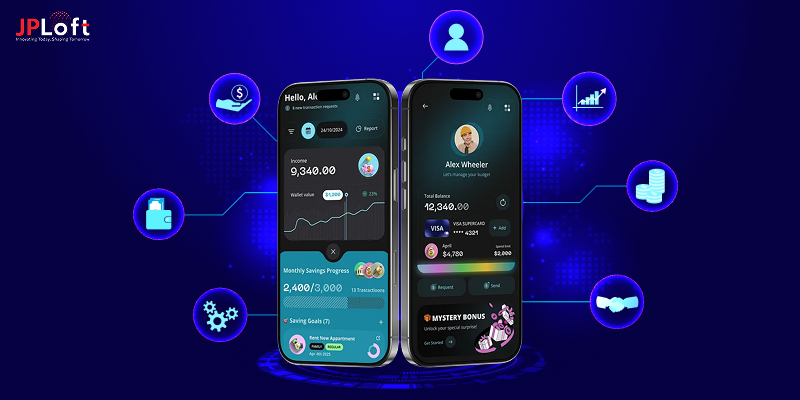Key Takeaways:
Fintech apps are experiencing rapid growth, driven by AI, blockchain, and open banking, with a focus on simplifying and personalizing money management.
The major fintech trends include BNPL, DeFi, and BaaS, creating new ways to borrow, invest, and launch fintech products faster.
Big data and real-time analytics are improving risk detection, credit scoring, and overall financial transparency.
The modern-day fintech users prioritize Sustainability and ethical finance, driving the development of eco-friendly fintech solutions.
Voice technology and advanced security tools, including biometrics, are making fintech apps safer and easier to use.
The fintech businesses can stay updated through industry reports, regulations, and fintech communities, and can plan for upcoming shifts.
JPLoft empowers fintech startups and enterprises to adopt the latest technologies and stay ahead in a changing market.
Fintech is one of the sectors that is experiencing significant growth in 2025 and is expected to maintain such a growth momentum beyond.
Such a momentum is shaped by the increasing focus on digitalization and improving financial literacy among the millennials and Gen Z audiences. Following such, the fintech leaders are focusing on and adopting the latest fintech trends to retain their competitiveness.
The common trends shaping the fintech apps include AI, blockchain, personalization, open banking, big data, and several others. The key goal behind the emergence of such trends is to simplify the fintech experience for users.
In this blog, we will discuss key fintech trends that are taking over the industry and are becoming a must-have feature for modern-day fintech apps.
Fintech App Market Statistics
Fintech apps are no more a niche in the global banking sector, but they are becoming the backbone of the sector. Such a fact can be better proven through the key industry statistics.
Some industry statistics supporting the growth of the Fintech space include:
-
Consumer banking apps crossed 2B downloads in the 12 months to June 2025 at a +5.1% YoY growth rate.
-
On Mastercard’s network, “more than two out of every three” in-person purchases are contactless; in the US, 65% of card transactions are contactless-enabled.
-
Open banking has moved from pilots to mass adoption. The UK hit 15.16M users in July 2025 (roughly one-third of adults), with ~30M open-banking payments in July alone.
-
BNPL remains sizable in the US. 91.5M Americans are expected to use BNPL in 2025 (up from 86.5M in 2024), despite tighter underwriting and merchant fees pressure.
-
Embedded finance is still a multi-trillion-dollar story. Global embedded finance is projected to reach 588.49 billion by 2030 at a CAGR of 32.8%.
These are some of the key statistics that show the growth of the fintech app and the key trends that are being supported and adopted by the audience.
Future Trends of Fintech Apps
Fintech in itself is a key disruption to the banking sector, which has reshaped how financial institutions work and how users conduct transactions.
Let’s explore some of the key trends that the fintech apps are following or need to adapt to retain their competitiveness and to offer a better service experience to the users.
1] AI-Driven Personalization
Fintech apps are starting to feel more like personal financial coaches. Through AI in finance, these apps are studying spending habits, income, and even lifestyle choices.
Based on such analysis, the fintech apps can suggest savings plans, loan offers, or investment tips that fit the user’s unique needs.
The use of AI in loan lending apps will speed up approvals and help detect risks early. The result is a more personalized experience where users feel the app understands their financial goals and guides them with confidence.
2] Open Banking Expansion
Open banking is reshaping how people manage money. Instead of depending on a single bank, users can now link multiple accounts through secure APIs inside one app. This gives them a complete picture of their finances and better plan their expenses and savings.
The fintech apps can use such real-time data from users’ diverse accounts to offer faster verification and better lending options. For users, it means fewer forms to fill out and quicker access to credit. For lenders, it ensures safer decisions based on reliable financial information.
3] Rise of BNPL and Alternative Credit Models
Another trend that is on the rise in the fintech space is BNPL, i.e., Buy Now, Pay Later, and its growth is expected to continue beyond 2025.
Along with BNPL, several other alternative lending models are appearing, such as income-based repayment plans and community-backed loans. Such are helping businesses to start money lending businesses based on such alternative models.
These alternatives are targeting the younger generations (including millennials and Gen Z) and offering underbanked groups easier access to credit.
For fintech entrepreneurs, offering flexible repayment terms builds loyalty and expands reach. Clear and transparent policies will matter most, since users want to understand what they are signing up for without hidden costs.
4] Big Data in Fintech
Data is becoming one of the strongest tools for fintech companies. Apps can process thousands of data points in real time, from spending patterns to repayment history.
This information is used to improve credit scoring, predict user needs, and detect unusual activity. For loan lending apps, big data means more accurate risk models and fewer defaults. Furthermore, for e-wallets, this means faster transaction processing and improved user experience.
Managing data in fintech is also essential to align with fintech compliance. The Fintech apps are required to submit timely reports and records to the assigned authorities. Hence, following such a trend is strictly required to be followed by the fintech firms.
5] Advanced Banking-as-a-Service (BaaS) Ecosystem
The growth of the fintech sector has further contributed towards the introduction of Banking-as-a-Service platforms are moving beyond basic payments.
They now offer a full ecosystem including KYC, compliance, digital wallets, lending, and even insurance services. For fintech startups, this means they can launch products faster, implement stronger mobile app background verification, and scale with fewer resources.
Developers don’t need to build every feature from scratch; instead, they can plug into ready-made services. Loan lending apps can benefit the most by using BaaS to handle complex back-end tasks while focusing on user-friendly design and innovative customer features.
6] Ethical and Eco-Friendly Fintech Solutions
Users, especially millennials and Gen Z, are demanding financial services that reflect their values. Fintech apps are responding by adding features like carbon footprint tracking for transactions, eco-investment portfolios, and transparent lending policies.
This shift is about building trust and aligning with the growing push for sustainability. An app that shows users how their money impacts the planet can build stronger loyalty.
Fintech apps that adopt eco-friendly practices can attract socially conscious customers and set themselves apart from traditional banks.
7] Decentralized Finance (DeFi)
DeFi is moving closer to the mainstream. Instead of being tied to traditional banks, users can access loans, savings, and trading through decentralized platforms. Fintech apps are beginning to integrate DeFi features like tokenized assets and blockchain-based lending apps.
While regulation is still catching up, the potential is big: faster cross-border payments, cheaper lending costs, and more financial independence.
For fintech entrepreneurs, building bridges between regulated finance and DeFi will create new opportunities and appeal to a tech-savvy audience looking for flexible money options. However, partnering with an experienced DeFi development company will help you get a profitable and scalable app.
8] Voice and Conversational Banking
Voice technology is becoming part of everyday life, and fintech apps are starting to use it for banking tasks. Instead of tapping through menus, users can simply ask their app to check balances, pay bills, or apply for a loan.
Natural language processing in fintech apps makes the experience feel simple and personal. From Voice banking to voice payments, these trends are improving accessibility for people who prefer speaking to typing.
Irrespective of the type of fintech app, whether a loan lending app, banking app, e-wallet, or any other, conversational features can guide users step by step, making applications faster and less stressful.
9] Strengthened Fraud Prevention and Security
Mobile app security will always be a top priority in fintech. With increasing cases of cyberfraud, apps are investing in stronger protection. As per reports, fintech accounts for approximately 27% of all cybersecurity incidents globally.
Biometric logins, device checks, and AI-driven fraud detection are becoming standard. Instead of waiting until fraud happens, apps will monitor activity in real time to stop suspicious actions.
For fintech apps, this is especially important since they handle sensitive personal and financial data. A strong focus on safety builds trust, which is the foundation of any successful financial app.
10] Increasing Financial Regulations
Governments across the world are introducing new and updating existing compliance for fintech companies to protect consumers.
This includes stricter guidelines for BNPL, new data privacy laws, and clear frameworks for crypto services. Such an approach further leads towards being a key fintech app development challenges.
For fintech entrepreneurs, compliance can no longer be optional. Building apps with regulation in mind from the start saves time, avoids fines, and improves customer trust. Keeping up with such changing policies ensures that your app continues operating smoothly.
How to Stay Up to Date with Trends?
The fintech sector is transforming rapidly than ever. From AI-powered automation to open banking and instant payments, new trends are shaping how fintech apps will perform.
Hence, in such a scenario, it is essential to keep an eye on these trends, but a key challenge that arises is how to stay up-to-date with these trends. To stay competitive, fintech app developers and businesses must not just follow the trends, but also need to integrate them into their mobile app design.
Here’s how you can stay ahead of what’s next.
1. Check Out Trusted Fintech Reports and Research Platforms
Keeping track of industry insights through reliable and trusted reports is the most effortless way to spot new opportunities.
You can check on reliable sources like KPMG’s Pulse of Fintech, CB Insights, Deloitte Fintech Report, and McKinsey’s Digital Banking Updates, which regularly publish deep analyses of market movements, consumer behavior, and technology adoption.
These reports help developers and founders understand the industry scenario better. Also, they highlight the key trends shaping the tech space, from the need to create an AI chatbot, planning for AI-driven credit scoring, real-time payments, to blockchain-based lending, and many others.
2. Keep an Eye on Regulatory and Compliance Changes
The fintech app compliance and regulations keep changing to keep both the user and entrepreneurs safe. But these trends can sometimes limit the innovation and growth.
For fintech apps targeting U.S. or Western markets, staying informed on any policy or compliance shift from the SEC, CFPB, or Federal Reserve can make a big difference.
For instance, the growing attention on open banking frameworks and data privacy laws across the U.S. and Europe is pushing fintech developers to build a fintech app that prioritizes user consent and data transparency.
3. Engage with Fintech Communities and Thought Leaders
Another key approach can be to join active online spaces where fintech discussions happen daily, like LinkedIn fintech groups, Slack communities, or Reddit.
These communities are often the first to discuss new trends before they become a part of the fintech apps. Whether it is biometric authentication, AI role in app development, risk management, or decentralized finance tools, every trend is part of these discussions.
Follow thought leaders, investors, and tech journalists who regularly share updates on evolving technologies and funding trends. Engaging in these spaces keeps your perspective fresh and helps you align your strategies with the latest market pulse.
4. Experiment and Innovate with New Technologies
Staying up to date isn’t only about following and copying trends. But it’s about experimenting and testing them. Ensure that, based on the current trends and customer expectations, you are experimenting with emerging fintech frameworks.
Such approaches can allow you to ensure that your app stays a way ahead of your competition and can attract new users.
5. Focus on Analytics and Customer Feedback
Focus on your app user data rather than just going through the industry reports and speculations. Pay attention to what features your users are using the most in your app. Also, take feedback from your customers regarding what features they expect to have in a fintech app.
Use analytics tools, A/B testing, and direct surveys to refine your app’s features and stay relevant to your users’ evolving expectations.
6. Collaborate With Other Industry Players
Introducing a whole new fintech trend can be challenging if you are just experimenting on your own. Rather than that, you can collaborate with other fintech players to stay ahead of industry trends.
Such collaborations can help control the experimentation budget, the mobile app development cost, as well as offer a convenient route to introduce a new trend or feature in the fintech space.
How JPLoft Can Help to Implement Fintech Trends In Your App?
Scaling your app in the fintech sector means focusing on the right mix of technology, design, and strategy. At JPLoft, we help entrepreneurs build fintech apps that meet users’ expectations and are ready for the future.
The expert developers at JPLoft work with the latest tools like AI, blockchain, and cloud technology to ensure that the fintech apps are smarter, safer, and align with key trends. As a leading fintech app development company, we focus on creating a solid back-end foundation while keeping the user experience simple and secure.
Such an approach helps our clients offer key features that users expect in today’s financial apps, as well as staying ready to deal with any unexpected trends.
We also focus on every fintech trend and changing regulations across global markets, so every app we build meets modern standards and compliance needs. From startups to enterprises, JPLoft supports fintech businesses at every stage, from idea to launch and beyond. Helping them stay innovative, competitive, and trusted in the fintech space.
Conclusion
The fintech industry is growing faster than ever, and 2025 is set to bring even more changes. From AI-driven banking to real-time payments and stronger security, these trends are shaping how people use and trust financial apps. Businesses that act early and invest in the right technology will stay ahead of the curve.
For fintech developers, staying updated means keeping an eye on new tools, changing laws, and user needs. Building apps that are secure, easy to use, and future-ready will be the key to long-term success.
FAQs
Some key trends to be followed include AI-based automation, blockchain integration, real-time payments, biometric security, and open banking. These technologies are helping fintech apps become faster, safer, and more user-focused.
Fintech is changing fast, and new technologies are shaping how people handle money. Staying updated with the latest trends helps businesses stay relevant, improve security, and meet user expectations in a growing digital market.
AI will make fintech apps more personal and efficient. It helps in areas like fraud detection, credit scoring, and customer support through chatbots and automation, making apps smarter and safer.
Businesses should stay updated with reports, attend fintech events, partner with industry players, and hire experienced developers. Keeping up with new tools, compliance rules, and design trends will help them stay ahead of the competition.
The technologies such as AI, blockchain, cloud computing, and real-time payments will shape the current as well as the future of fintech. These tools make apps faster, smarter, and more secure while reshaping how users manage transactions and finances.













Share this blog